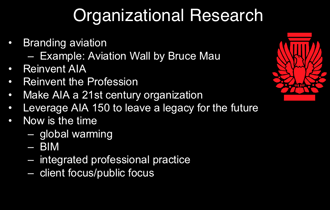|
|
The client focus, the consumer focus, is also coming into the picture. Over the last 25 years or so, much more information is available to consumers in the marketplace. The push toward healthier, more sustainable communities and buildings—tying facilities to human performance—has resulted in research in those areas. We have talked about the work by others—that they are beginning to identify the impact that facilities have on performance and how this is more clearly understood by consumers. The first job, as part of the conversation, was to convey a tremendous sense of urgency that change is essential; the cycle is being more and more compressed. It was mentioned that if we don’t find ways of reinventing ourselves every four or five years, we will continue lose ground even more rapidly than we have over the last several decades.
We moved from that topic into the opportunity that we see with this year’s celebration of AIA150. We have spent a lot of time of looking back, focusing on the institutions that have brought us to this point. A legacy that fundamentally changes our approach to the profession and practice of architecture still needs to emerge.
James Suehiro:
First of all, the question was organization of research. I don’t think that architects take their station well. The other aspect is that when we went through this exercise what we saw in the word organization. We thought, of course, about making the AIA a 21st-century organization.
>
01 02 03 04 05 06 |
|

|
